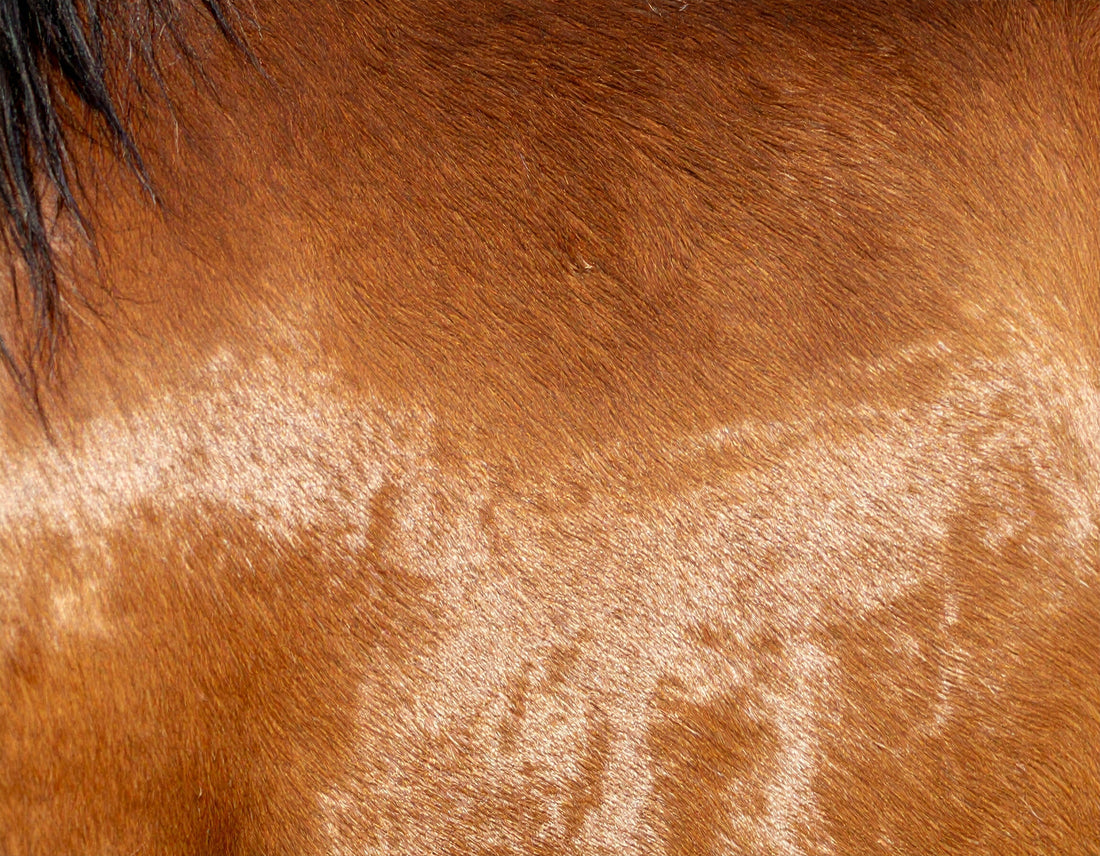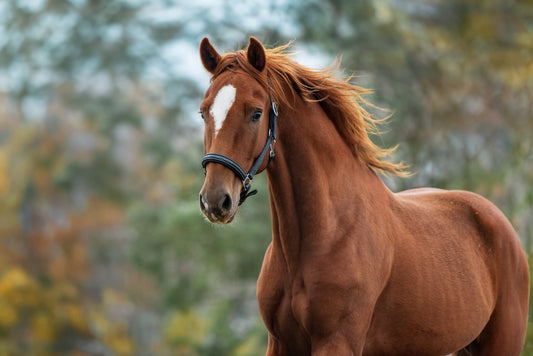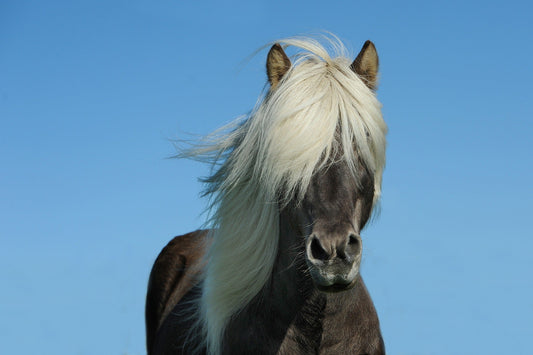Pferdeernährung im Herbst: Vom glänzenden Sommerfell zum flauschigen Teddybärfell
8 Min

Der Herbst ist da! Die Blätter fallen, die Tage werden kürzer… und Ihr Pferd verwandelt sich in einen flauschigen Teddybären. Und manchmal braucht es beim Fellwechsel etwas mehr Unterstützung von uns.
Warum verlieren Pferde ihr Fell ?
Der Fellwechsel wird vom Tageslicht gesteuert. Wenn die Tage kürzer werden, erhält der Körper Ihres Pferdes das Signal: Zeit, das kuschelige Winterfell wachsen zu lassen.
Der Fellwechsel ist die natürliche Art und Weise, wie Pferde sich an die Jahreszeiten anpassen. Zweimal im Jahr durchlaufen sie einen kompletten Fellwechsel. Im Frühling verlieren sie ihr dickes, flauschiges Winterfell, um Platz für ein glatteres, leichteres Sommerfell zu schaffen. Im Herbst geschieht das Gegenteil, wodurch sie auf die kälteren Monate vorbereitet werden.
Doch das ist keine oberflächliche Veränderung. Die Häutung ist eine enorme Belastung für den Stoffwechsel und das Immunsystem . Sie erfordert viel Energie und einen erhöhten Bedarf an wichtigen Nährstoffen wie Proteinen, Vitaminen und Spurenelementen. Dieser Prozess ist für den Körper sehr anstrengend, und wenn die Nährstoffversorgung unzureichend ist, kann auch die Immunität nachlassen.
Geht das Gras aus?
Im Spätsommer und Herbst lässt die Weidequalität nach. Oft so stark, dass Ihr Pferd nicht mehr genügend Nährstoffe allein durch Gras aufnehmen kann. Dann ist es Zeit, zusätzliches Raufutter und, je nach Bedarf Ihres Pferdes, das passende Ergänzungsfutter anzubieten .
Das beste Raufutter hängt von der Pferderasse, dem Alter, der Arbeitsbelastung, der Zahngesundheit und eventuellen Unverträglichkeiten ab. Einige Beispiele:
- Leichtfuttrige und zuckerempfindliche Pferde: Wählen Sie eine zuckerarme Option wie Vitalbix Daily Complete .
- Sportpferde, die zusätzliche Energie benötigen: ein Leistungsfutter wie Reverdy Adult Energy .
- Freizeitpferde und -ponys in leichter Arbeit: Reverdy Adult, Eine ausgewogene Option mit moderatem Energiegehalt wie Reverdy Adult .
- Ältere Pferde, Pferde mit Zahnproblemen: Brei , nährstoffreiches Raufutter oder seniorengerechte Futtermittel wie NutriMash von Vitalbix .
- Pferde mit Magenproblemen: Adult Specific Energy von Reverdy .
Warum die Ernährung während des Fellwechsels wichtig ist
Sich ein brandneues Fell wachsen zu lassen ist nicht Es geht nur ums Aussehen: es ist Der Fellwechsel ist eine anstrengende Angelegenheit für den Körper Ihres Pferdes. Er erhöht den Bedarf an Nährstoffen, insbesondere an Mineralien wie Kupfer, Zink und Mangan . Je weniger Mängel Ihr Pferd hat, desto reibungsloser und schneller verläuft der Fellwechsel. Da der gesamte Umwandlungsprozess Energie verbraucht, kann er das Immunsystem vorübergehend schwächen, wodurch eine ausgewogene Ernährung umso wichtiger wird.
Hochwertiges Raufutter, kombiniert mit einem auf Ihr Pferd abgestimmten Kraftfutter, ist meist die Lösung. Füttern Sie nur Raufutter? Dann kann der Fellwechsel länger dauern. In diesem Fall... Ein Ergänzungsfuttermittel zur Fellpflege kann einen hilfreichen Schub geben.
Entdecken Sie hier unsere Lieblingsmäntel .
Wichtigste Erkenntnisse 🍁
- Als Reaktion auf die kürzeren Tageslichtstunden werfen Pferde ihr Fell ab und bilden im Herbst ein dichtes Winterfell und im Frühling ein leichteres Sommerfell.
- Der Fellwechsel ist energieintensiv und erhöht den Bedarf an Proteinen, Vitaminen und Mineralstoffen wie Kupfer, Zink und Mangan.
- Die abnehmende Weidequalität im Herbst bedeutet, dass Pferde möglicherweise nicht genügend Nährstoffe allein durch Gras aufnehmen können, weshalb zusätzliches Raufutter und ausgewogenes Futter unerlässlich sind.
- Die richtige Ernährung hängt von der Pferdeart und den Bedürfnissen ab: zuckerarme Ergänzungsfuttermittel für leichtfuttrige Pferde, Leistungsfutter für Sportpferde, seniorengerechte Futtermischungen für ältere Pferde und magenschonende Rezepturen für empfindliche Pferde.
- Eine angemessene Ernährung während des Fellwechsels unterstützt den Stoffwechsel, stärkt das Immunsystem und sorgt für einen reibungslosen Fellwechsel.
- Eine Ernährung ausschließlich mit Raufutter kann den Fellwechsel verlangsamen, aber gezielte Ergänzungsmittel können dazu beitragen, dass das Fell glänzend und gesund bleibt.
🍂 Eine ausgewogene Herbsternährung hilft Pferden dabei , den Übergang vom glänzenden Sommerfell zum flauschigen Winterfell reibungslos zu gestalten und dabei gesund und energiegeladen zu bleiben.
Mit der richtigen Unterstützung wird Ihr Pferd gesund und glücklich durch den Herbst kommen und bereit sein, sein flauschiges Winterfell in voller Pracht zu präsentieren.
- Wenn du dich für eine Auswahl entscheidest, wird die Seite komplett aktualisiert.
- Wird in einem neuen Fenster geöffnet.


